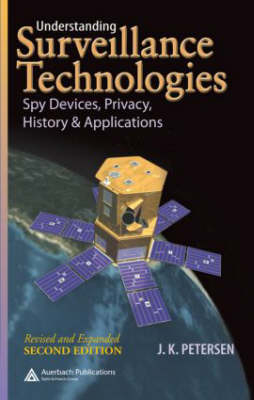
Understanding Surveillance Technologies
Spy Devices, Privacy, History & Applications, Second Edition
Seiten
2007
|
2nd New edition
Auerbach (Verlag)
978-0-8493-8319-9 (ISBN)
Auerbach (Verlag)
978-0-8493-8319-9 (ISBN)
- Titel erscheint in neuer Auflage
- Artikel merken
Zu diesem Artikel existiert eine Nachauflage
Reflects developments in aerial, radio, and telecommunications that affect government, local security, and corporations. This book features information on RFID chips, face recognition systems, Homeland Security initiatives and legislation, mass surveillance methods, voice over IP technology, higher resolution satellite images, and radar imaging.
Understanding Surveillance Technologies demystifies spy devices and describes how technology is used to observe and record intimate details of people’s lives—often without their knowledge or consent. From historical origins to current applications, it explains how satellites, pinhole cameras, cell phone and credit card logs, DNA kits, tiny microphones (“bugs”), chemical sniffers, and implanted RF/ID chips have enabled us to create a two-edged sword—devices that promise security while, at the same time, eroding our privacy. Understanding Surveillance Technologies is profusely illustrated with extensive references and indexes, laying the groundwork for more specialized texts on specific technologies. It covers each of the major sensing devices and explains how they are used in civilian, criminal justice, scientific, national security, and military applications. It also includes recent changes in legislation and the organization of the intelligence community, and discusses how equal access to high-tech sensing devices and encryption schemes has changed society.
Understanding Surveillance Technologies is modular, so the chapters can be read in any order, and is written in an accessible, somewhat narrative style, to suit the needs of journalists/newscasters, privacy organizations, educators, civic planners, and technology centers. It is appropriate as an adjunct reference for criminal justice/law enforcement/military, and forensic trainees, and as a textbook for courses in Surveillance Studies, Sociology, Communications, and Political Science. Now in its second edition, with 1,000 pages and more than 700 diagrams, it is still the only text that comprehensively conveys the breadth of the field.
Understanding Surveillance Technologies demystifies spy devices and describes how technology is used to observe and record intimate details of people’s lives—often without their knowledge or consent. From historical origins to current applications, it explains how satellites, pinhole cameras, cell phone and credit card logs, DNA kits, tiny microphones (“bugs”), chemical sniffers, and implanted RF/ID chips have enabled us to create a two-edged sword—devices that promise security while, at the same time, eroding our privacy. Understanding Surveillance Technologies is profusely illustrated with extensive references and indexes, laying the groundwork for more specialized texts on specific technologies. It covers each of the major sensing devices and explains how they are used in civilian, criminal justice, scientific, national security, and military applications. It also includes recent changes in legislation and the organization of the intelligence community, and discusses how equal access to high-tech sensing devices and encryption schemes has changed society.
Understanding Surveillance Technologies is modular, so the chapters can be read in any order, and is written in an accessible, somewhat narrative style, to suit the needs of journalists/newscasters, privacy organizations, educators, civic planners, and technology centers. It is appropriate as an adjunct reference for criminal justice/law enforcement/military, and forensic trainees, and as a textbook for courses in Surveillance Studies, Sociology, Communications, and Political Science. Now in its second edition, with 1,000 pages and more than 700 diagrams, it is still the only text that comprehensively conveys the breadth of the field.
Introduction
Introduction & Overview
Acoustic Surveillance
Audio
Infra/Ultrasound
Sonar
Electromagnetic Surveillance
Radio
Radar
Infrared
Visual
Aerial
Ultraviolet
X-Rays
Chemical & Biological Surveillance
Chemical & Biological
Biometrics
Animals
Genetics
Miscellaneous Surveillance
Magnetic
Cryptologic
Computers
Index
| Erscheint lt. Verlag | 5.2.2007 |
|---|---|
| Zusatzinfo | 5 Tables, black and white; 464 Illustrations, black and white |
| Verlagsort | London |
| Sprache | englisch |
| Maße | 178 x 254 mm |
| Gewicht | 2041 g |
| Themenwelt | Technik ► Bauwesen |
| ISBN-10 | 0-8493-8319-6 / 0849383196 |
| ISBN-13 | 978-0-8493-8319-9 / 9780849383199 |
| Zustand | Neuware |
| Haben Sie eine Frage zum Produkt? |
Mehr entdecken
aus dem Bereich
aus dem Bereich
Grundlagen und Vorgehensweisen
Buch | Softcover (2021)
Springer Fachmedien Wiesbaden GmbH (Verlag)
CHF 53,15
Bemessung von Stahlbauten nach Eurocode mit zahlreichen Beispielen
Buch | Hardcover (2024)
Springer Vieweg (Verlag)
CHF 83,95
Kommentar zu VOB/C ATV DIN 18340, ATV DIN 18299
Buch | Softcover (2024)
DIN Media (Verlag)
CHF 96,55



